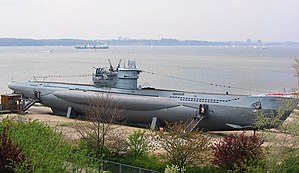
Type VII U-boats were the most common type of German World War II U-boat. 703 boats were built by the end of the war. The lone surviving example, U-995, is on display at the Laboe Naval Memorial located in Laboe, Schleswig-Holstein, Germany.

Type XXI submarines were a class of German diesel–electric Elektroboot submarines designed during the Second World War. One hundred and eighteen were completed, with four being combat-ready. During the war only two were put into active service and went on patrols, but these were not used in combat.

The Type 212A is a class of diesel-electric submarine developed by Howaldtswerke-Deutsche Werft AG (HDW) for the German Navy, and the Italian Navy where it is known as the Todaro class. It features diesel propulsion and an additional air-independent propulsion (AIP) system using Siemens proton exchange membrane (PEM) compressed hydrogen fuel cells. The submarines can operate at high speed on diesel power or switch to the AIP system for silent slow cruising, staying submerged for up to three weeks with little exhaust heat. The system is also said to be vibration-free and virtually undetectable.

German submarine U-995 is a Type VIIC/41 U-boat of Nazi Germany's Kriegsmarine. She was laid down on 25 November 1942 by Blohm & Voss in Hamburg, Germany, and commissioned on 16 September 1943 with Oberleutnant zur See Walter Köhntopp in command. She is preserved at Laboe Naval Memorial near Kiel.
German submarine U-1276 was a Type VIIC/41 U-boat of Nazi Germany's Kriegsmarine, built for service during World War II. She was laid down at Bremer Vulkan of Bremen-Vegesack on 13 July 1943. She was commissioned 6 April 1944 with Oberleutnant zur See Karl-Heinz Wendt in command. U-1276 was equipped with a submarine snorkel when she sailed on her last cruise.
Friedrich Krupp Germaniawerft was a German shipbuilding company, located in the harbour at Kiel, and one of the largest and most important builders of U-boats for the Kaiserliche Marine in World War I and the Kriegsmarine in World War II. The original company was founded in 1867 but went bankrupt and was bought out by Friedrich Krupp. Krupp was very interested in building warships and in the time before the First World War built a number of battleships for the Kaiserliche Marine, including SMS Posen, SMS Prinzregent Luitpold, SMS Kronprinz, and SMS Sachsen. A total of 84 U-boats were built in the shipyard during the war. After the war it returned to the normal production of yachts and transports.
German submarine U-365 was a Type VIIC U-boat built for Nazi Germany's Kriegsmarine for service during World War II. She served exclusively against the Arctic Convoys from Britain to Murmansk and Archangelsk, principally targeting the Soviet forces which greeted the convoys in the Barents Sea.
German submarine U-1000 was a Type VIIC/41 U-boat built during World War II for service in Nazi Germany's Kriegsmarine.
German submarine U-735 was a Type VIIC U-boat built for Nazi Germany's Kriegsmarine for service during World War II.
German submarine U-254 was a Type VIIC U-boat of Nazi Germany's Kriegsmarine, built for service in the Second World War and the Battle of the Atlantic. She was a mildly successful boat which carried out three war patrols, but fell victim to a freak accident during an attack on an Allied convoy in the mid-Atlantic Ocean on her third patrol and was lost.
German submarine U-596 was a Type VIIC U-boat built for Nazi Germany's Kriegsmarine for service during World War II. She was laid down on 4 January 1941 by Blohm & Voss in Hamburg as yard number 572, launched on 17 September 1941 and commissioned on 13 November under Kapitänleutnant Gunter Jahn. He was replaced on 28 July 1943 by Oberleutnant zur See Victor-Whilhelm Nonn who was superseded by Oblt.z.S. Hans Kolbus in July 1944.
German submarine U-1018 was a German Type VIIC/41 U-boat, built during World War II for service in the Battle of the Atlantic. The U-boat was fitted with the Schnorchel underwater-breathing apparatus which enabled her to stay under-water for extended periods thus avoiding detection by enemy warships.
German submarine U-82 was a Type VIIC U-boat of Nazi Germany's Kriegsmarine during World War II.

German submarine U-1163 was a Type VIIC/41 U-boat of Nazi Germany's Kriegsmarine during World War II.

German submarine U-1022 was a Type VIIC/41 U-boat of Nazi Germany's Kriegsmarine. She was laid down on 6 May 1943 by Blohm & Voss in Hamburg, Germany, and commissioned on 7 June 1944, the day after the Allied landings in Normandy, with Kapitänleutnant Hans-Joachim Ernst in command. She sank two ships for a total of 1,720 GRT. After the war she was handed over to the Allies and sunk in Operation Deadlight.
German submarine U-603 was a Type VIIC U-boat built for Nazi Germany's Kriegsmarine for service during World War II. She was laid down on 27 February 1941 by Blohm & Voss, Hamburg as yard number 579, launched on 16 November 1941 and commissioned on 2 January 1942 under Kapitänleutnant Kurt Kölzer.
German submarine U-327 was a Type VIIC/41 U-boat of Nazi Germany's Kriegsmarine during World War II.

German submarine U-1202 was a Type VIIC U-boat built for Nazi Germany's Kriegsmarine for service during World War II. She was laid down on 28 April 1943 by Schichau-Werke, Danzig as yard number 1572, launched on 11 November 1943 and commissioned on 27 January 1944 under Kapitänleutnant Rolf Thomsen.

German submarine U-1064 was a Type VIIC/41 U-boat built for Nazi Germany's Kriegsmarine for service during World War II. She was laid down on 23 September 1943 by Friedrich Krupp Germaniawerft, Kiel as yard number 701, launched on 22 June 1944 and commissioned on 29 July 1944 under Korvettenkapitän Karl-Hermann Schneidewind.
This page is based on this
Wikipedia article Text is available under the
CC BY-SA 4.0 license; additional terms may apply.
Images, videos and audio are available under their respective licenses.





